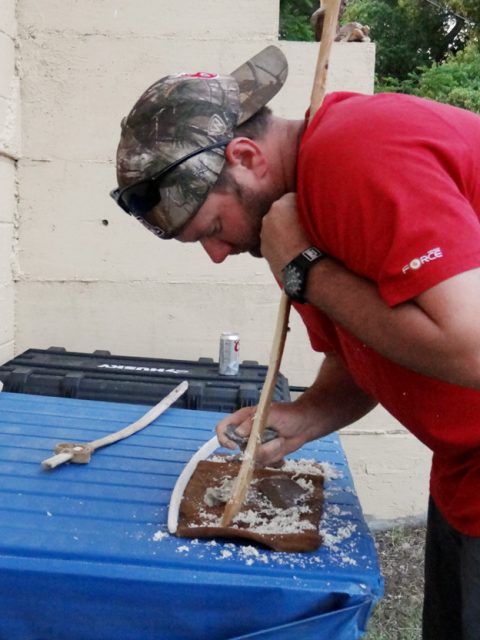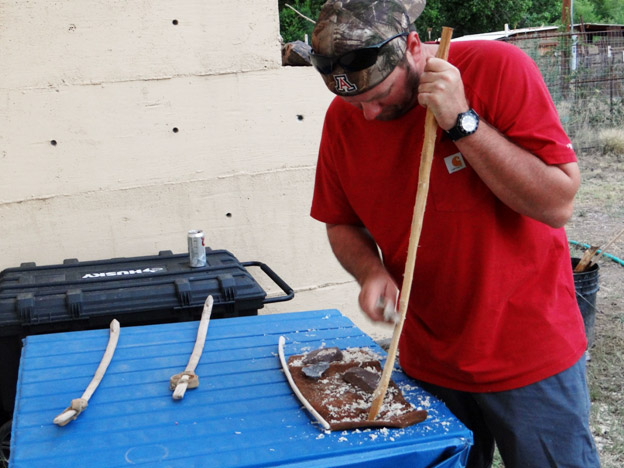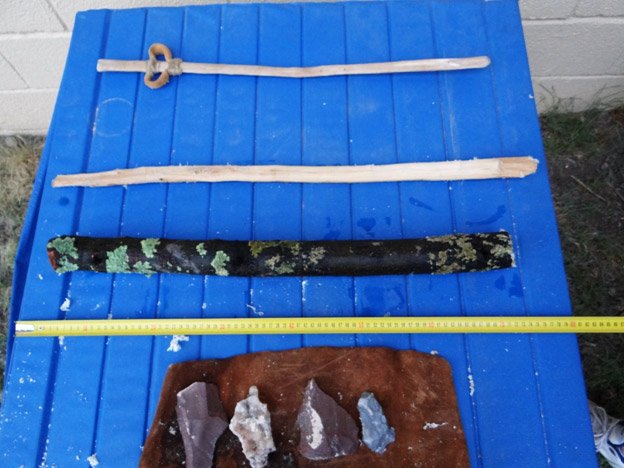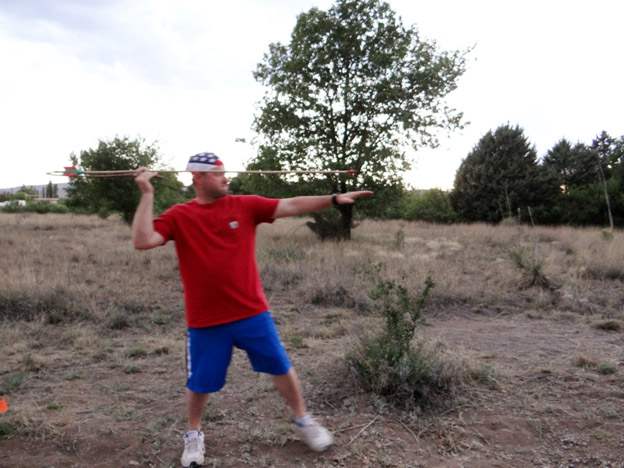- Home
- >
- Preservation Archaeology Blog
- >
- Experimental Archaeology: Basketmaker Atlatl
June 20, 2017—One of the best ways to understand how ancient peoples lived is to study experimental archaeology. Experimental archaeology is reconstructing tools made by ancient peoples using the same means they used to create them. The atlatl was a game-changing advancement for ancient people. It was designed primarily for hunting large game animals and possibly for protection from threats. Before the invention of the atlatl, humans had to throw spears purely on shoulder and triceps power, which was not effective for long-distance shots. Because the atlatl acts as a lever for the dart, it greatly enhances speed, velocity, and distance. This tool greatly increases the chances of making a kill shot, which in turn enables the wielders to provide meat for their families or protect them from threats.
 |
 |
The wood I used in the construction of the atlatl was scrub oak. This type of wood is extremely dense and can hold its shape when carved into thin pieces, keeping the tool as light as possible and easy to wield. The oak tree I used had a diameter of about 2 ½ to 3 inches. Since atlatls are no longer in production I have had to use my imagination to reconstruct it in the manner I think closely resembles the methods ancients would have used. I used several tools in the construction, including stone flakes, stone scraper tool, chalcedony rasp, stone knife, and a sandstone cobble. I worked the wood, shaping it into a piece about 18 inches long, an inch and a half wide, and left one end in a triangular shape in order to provide a hook to insert a spear shaft.
On the opposite end from the hook, I cut a finger notch into the sides of the atlatl to install the finger loops. The finger loops are made from a leather strap folded in half lengthwise with a slit cut in the middle to pull it onto the handle. Once the leather strap is in place, sinew wraps around the leather to hold the loops in place (I used wax string in lieu of sinew). On the portion of the leather that is cut and slid over the shaft, I wove the sinew in a cross pattern. On the other end of the leather I wrapped the sinew around the shaft in a circular pattern. I placed hemp rope on top of the sinew to further strengthen and for aesthetics.
After the initial construction I sanded the wood using a sandstone cobble and handfuls of sand from the San Francisco River until I achieved a high degree of smoothness. After completion I rubbed oil on the shaft to seal the wood.
The experience of making a Basketmaker style atlatl has been awesome. By using primitive tools I have gained a better understanding of how ancient peoples may have constructed their atlatls. Experimental archaeology has been vital to my understanding of the artifacts I encounter in excavation, and it gives me a newfound respect for ancient technology.
8 thoughts on “Experimental Archaeology: Basketmaker Atlatl”
Comments are closed.
Explore the News
-
Join Today
Keep up with the latest discoveries in southwestern archaeology. Join today, and receive Archaeology Southwest Magazine, among other member benefits.



How accurate was your atlatl?
Steve got two shots on top of each other “Robin Hood style” in the flank of our deer target shortly after making this atlatl, so I’d say it turned out pretty well!
Steve-O Uzzle, I’m so proud of this young man, this experience has to be awesome. You’re hard work will pay off in the long run. Your trip looks awesome. Keep up the good work. See you when you get home. Love you my good frienf
Awesome job Stephen! So proud of your achievements!
Stephen, we are so proud of you and your dedication and achievements!
Thanks everyone, I had a great time making the atlal. Also, it works great!
Hi Steve,
Great atlatl. I’m working on one derived from a design found at Tikal in Peru. Problem is the darts: Did you make/buy your darts? If you made them, did you make them out of river reed (I’m thinking of using 5 foot 5/16ths doweling)? Now, how do we fix the fletching?
Thanks for your help,
Dennis
Stephen: Thanks for your dedication and skill! Really appreciate how you are preserving this knowledge for future generations!